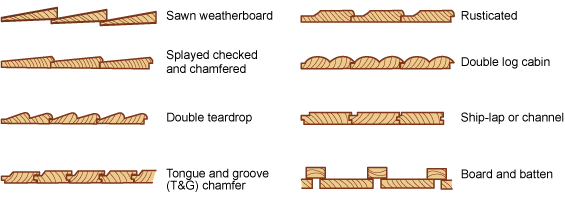Profiles and seasoning
Profiles
Timber cladding is generally produced from 150 - 200 mm wide boards. Wider boards are more likely to cup or split. Various profiles are available from manufacturers.

Seasoning
Timber will take up and lose moisture and expand and contract accordingly. Timber cladding is usually supplied as 'dry', 'kiln dried' or 'seasoned', with a moisture range of 10 - 15%. Exceptions include western red cedar, cypress pine and hardwood weatherboards, which may be supplied unseasoned.
Unseasoned cladding will shrink as it dries. So, allowance must be made for shrinkage by increasing the overlap of boards. Wider unseasoned boards may also develop slight cupping across the face unless they are restrained. Unseasoned hardwood boards should be fixed as soon as possible after delivery.
